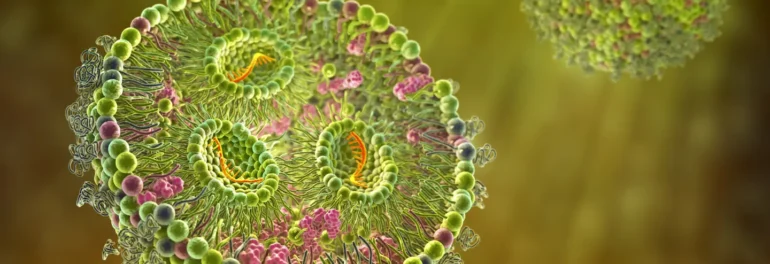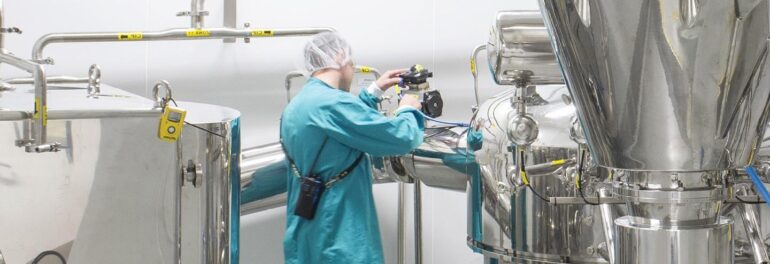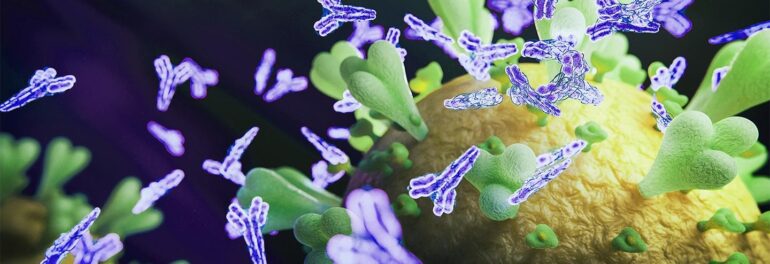Flow chemistry for the continuous production of small molecule active pharmaceutical ingredients (APIs) can provide significant safety, environmental, cost and quality benefits. Effective development and implementation of continuous manufacturing solutions requires a combination of chemistry and engineering expertise and the knowledge and experience to determine which processes are suitable for conversion from batch to continuous operations.
Old Approach, but New to Pharma
There is ongoing discussion in the pharmaceutical industry today about the potential benefits of flow chemistry and continuous processing. This approach to chemicals manufacturing is not new; it has been widely applied for decades in the chemical process industries for the consistent, economical production of high-volume products.
However, continuous processing is a new concept in the pharma industry, which was founded using a batch production approach. It is also being contemplated at a time when the demand for large-volume manufacturing is shrinking, because blockbuster drugs are being replaced by small-volume, highly potent, complex drug substances that make the effective use of continuous processing more challenging. In this conservative industry, new technologies are often slow to be adopted, because the safety and quality of the drugs produced can be assured using established processing knowledge and techniques.
Many Potential Benefits
Despite these challenges, there are many benefits of continuous processing — flow chemistry for small molecule API production — that can be realized. Regulatory agencies, such as the U.S. Food and Drug Administration and the European Medicines Agency now encourage the adoption of continuous processes to achieve more consistent quality and potentially lower costs and to accelerate drug development.
For API manufacturing, one of the greatest benefits of continuous processing is alleviation of process safety hazards associated with reactions that involve hazardous/toxic reagents and/or are highly exothermic. In some cases, flow chemistry enables the development of processes that cannot safely be performed under batch conditions, creating the opportunity to access new molecular structures.
Continuous processing also typically involves a much smaller physical footprint, reduced equipment sizes, the consumption of small quantities of solvent and the generation of fewer unwanted side products and reduced waste streams, resulting in greater processes efficiencies and improved environmental profiles. Automation and online, real-time monitoring of process conditions also provide greater process control, often leading to improved product yields and quality. When reactor geometries and designs remain the same, scale-up of flow chemistry processes is also simpler than scale-up of conventional batch reactions, leading to a reduction of development times.
Drivers at Albemarle Fine Chemistry Services
Albemarle Fine Chemistry Services has been employing continuous processing and flow chemistry — often incorporated into semi-continuous, multi-step synthetic routes — for decades. Process safety has been a primary driver. Flow chemistry involves the reaction of minimal quantities of reagents at any given time, preventing the buildup of excess reactants and allowing precise control of reaction conditions –– pressure, temperature, flow rate and stoichiometric ratios.
The latter is important not only for preventing the buildup of hazardous reactants, but also for the prevention of unwanted side reactions that can lead to undesirable impurities and lower yields. Control of reactant ratios is much easier to accomplish in a continuous process than under batch conditions. This control also simplifies reactions that would have to be run under very dilute conditions in a batch scenario. Incorporating continuous distillation for recycling of the solvent can also significantly reduce the quantity of solvent and size/number of storage tanks required.
Finally, flow chemistry is generally more efficient than batch operations, particularly when large quantities of product must be produced; more material can be generated using equipment of similar size (or the same quantity in much smaller equipment) due to the greater productivity of continuous processes.
Typical Components of a Continuous Process
Albemarle FCS performs continuous production processes in continuous stirred-tank reactors (CSTRs). These reactors are designed to operate under continuous flow conditions and make it possible, typically, to perform processes in a 200-gallon reactor that under batch conditions require 2000-gallon tanks.
Many pharma companies and contract manufacturers are also exploring the use of microreactors designed specifically for fine chemistry processes. With these microreactors, scale-up is achieved by numbering up — adding more of the same microreactors in parallel — rather than increasing the size of the reactor. This option shows significant promise to reduce capital expenditures, but typically requires additional development time up front. It is presently too soon to know what impact this technology will ultimately have.
Once a reaction is complete, the product must be isolated and purified. For these activities, Albemarle FCS uses various types of continuous separation technology, including liquid/liquid extraction columns, continuous decantation and continuous filtration/centrifugation.
In many cases, batch processes that involve approximately 10,000 gallons of material can be converted to liquid/liquid extraction systems involving a couple of 500-gallon feed tanks and a single column, resulting in a significant increase in volume throughput.
For pharmaceutical intermediates and APIs, continuous filtration and centrifugation are more challenging due to the very high purity levels required. Physical separations can be quite difficult, and often with existing continuous processing solutions it is not yet possible to meet those high specifications. As a result, batch processing is often performed when physical separations are needed.
Continuous distillations include flash, wiped-film and continuous fractionation, providing manufacturers with several options. Unlike continuous separation technologies, continuous distillation solutions have been widely used for the production of high-purity fine chemicals, including pharmaceutical intermediates and active ingredients.
Converting from Batch to Continuous
At FCS, new products are typically developed as batch processes in the lab, with most early quantities produced in a batch fashion owing to simplicity and cost. As processes are scaled up, conversion to continuous processing becomes more attractive in some cases. In rare cases where the process cannot be performed in batch mode, a continuous solution will be designed from the outset.
One challenge is to identify the processes that are good candidates for conversion to flow chemistry. In general, reactions that involve solid reactants or that result in the production of a solid product are less suited for continuous processing, owing to the challenges associated with manipulating solid materials under flow conditions. Beyond that, the processes that are typically converted to continuous operation involve process safety or solvent handling issues or are of sufficiently large volume to enable realization of improved process efficiencies.
The key steps involved in converting from batch to continuous operation include:
- Determination of which steps in a process are candidates for development as continuous processes or conversion to continuous processes;
- Identification of the key process variables that must be monitored and controlled during continuous flow operations, which may include temperature, pressure, stoichiometry, concentration, mixing intensity, and other variables;
- Empirical quantification of the reaction rates of the desired reactions versus unwanted side reactions; and
- Through design of experiments, identification of how the key variables affect the yield and quality of the reaction steps.
Hybrid Solutions are Common
Often, part of a process is suitable for continuous or semi-continuous production, while other parts of the process are best achieved in batch mode. In other cases, the entire process can be operated under flow conditions.
For example, a peroxide oxidation process at Albemarle FCS that was run under very dilute batch conditions due to process safety concerns was partially converted to flow chemistry. The oxidation step was converted from a 1,000-gallon batch reactor to a 100-gallon CSTR with simultaneous addition of the peroxide and another key reactant. The foaming of the peroxide was used to carry the material from the CSTR to the next vessel, where a batch step was completed. The product was then separated from the reaction mixture using continuous extraction and purified using batch crystallization, followed by continuous distillation.
In another case, the entire process was performed in continuous mode, with a specified amount of the final product collected as a lot and then analyzed. This reaction also involved very dilute conditions in batch mode due to safety concerns.
In general, the determination of whether a process is suitable for conversion to continuous mode depends on the economics, the sensitivity and the size/volume of each step/unit operation. Another important factor is access to installed assets. If it is necessary to invest in new equipment and engineering solutions to implement a continuous process, the costs will be more challenging to justify.
Engineering Intensive
An equally important consideration to weigh when exploring the adoption of continuous processing is the fact that often flow chemistry solutions are more expensive to implement up front than batch processes, because they are significantly more engineering-intensive.
It is essential to implement a team approach that involves chemists skilled in organic chemistry along with the equipment-focused expertise of chemical engineers. For manufacturers who are largely chemistry-focused, it is important to intentionally establish a strong team of chemists and chemical engineers, because many of the crucial success factors for flow chemistry relate to engineering issues.
A Unique Combination of Skills and Capabilities
For contract development and manufacturing organizations (CDMOs) like Albemarle FCS, continuous processes may enable the provision of better economics over the long term. Careful and precise determination and definition of the design space provide more consistent processes with improved productivity, yields, quality and cost. Flow chemistry also provides CDMOs with access to novel chemistries and products that cannot practically be produced under batch conditions due to safety or selectivity issues.
The key to successful development and implementation of continuous manufacturing for small molecule pharmaceutical intermediates and APIs is recognition of the processes that are suitable for flow chemistry and appropriate process design.
Albemarle FCS has been pursuing continuous and semi-continuous operations for many years, and during that time we have gained significant knowledge and expertise with respect to the engineering requirements for flow chemistry and a deep understanding regarding the suitability of processes for the continuous model.
We have strong R&D teams staffed with experienced PhD organic chemists and chemical engineers with extensive backgrounds in the development of continuous processes at our Tyrone, Pennsylvania and South Haven, Michigan sites. These groups collaborate on a regular basis, and their efforts are integrated into both development and commercial operations. With this strong internal capability, Albemarle FCS has no need to seek engineering assistance from outside service providers.
Furthermore, we have the ability to perform batchwise and continuous processes and the capability to switch back and forth as appropriate for any given unit operation. Access to this toolbox of production paradigms enables Albemarle FCS to provide our customers with the ability to identify the optimal processing solution from the perspective of yield, productivity, scalability, time and cost.
Over the years, approximately 25–35% of our processes have been implemented in a continuous manner. When considered from a volume perspective, that portion increases to 40–50%, owing to the fact that the process that are converted to flow chemistry are typically associated with the largest-volume products.
Originally published on PharmasAlmanac.com on August 12, 2019.







